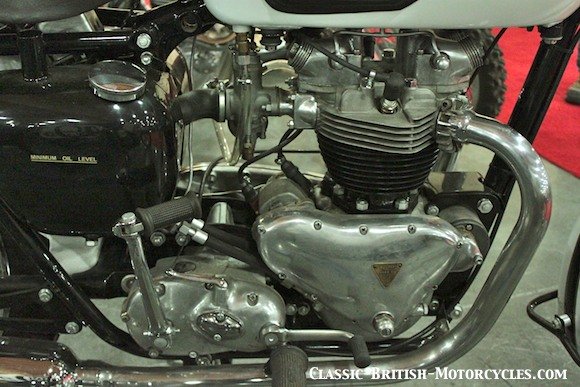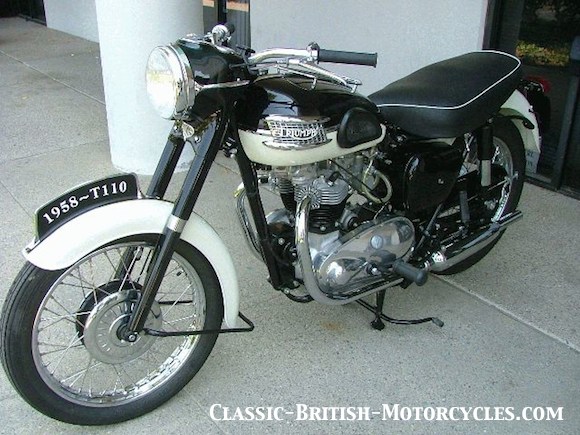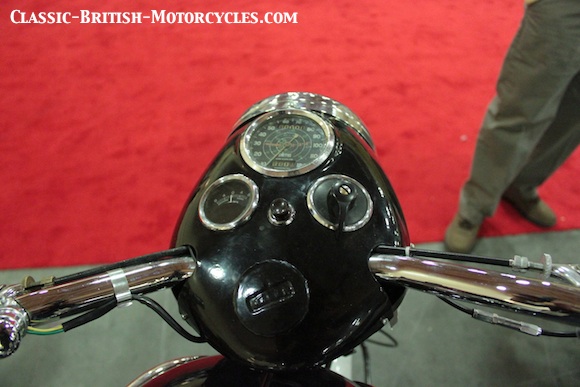1958 Triumph T110 Tiger
1958 TRIUMPH T110 TIGER – WHAT’S IN A NAME?
Triumph’s naming convention followed a couple paths. But the one the Tiger was on always starts with a “T” for Triumph, then the next set of digits were supposed to reflect the bike’s top speed. The first in the Tiger lineup was a 250cc single launched in the late 1930s. It was called the Tiger T70, presumably good for a top speed of 70 mph. Next up was the Tiger T80 which was a 350cc single. Then came the T90 which was a 350 twin, and being a “Tiger” meant that it was the ‘hot rod-version’ of the base 350 twin, known as the 3TA ‘Twenty-One’ (because 350cc = 21 cubic inches). It took a 500 twin to break into triple digits. Right after WWII when civilian production resumed, they juiced up the 5T Speed Twin with hotter cams and higher compression, creating the Tiger T100, which the world was to presume would go “ton up” (hit 100 mph). When they expanded the 500 twin to a 650 in 1950, a hotter Tiger version was soon to follow. The 650 T110 Tiger bowed in 1953, and remained one of the hottest bikes you could buy until the Triumph Bonneville in 1959, which was called the T120, by the way. When the Bonneville was bumped from 650 to 750 in 1973, it became the T140. I don’t think anyone actually believed, at that point, that an oil-in-frame Bonneville was good for 140 mph. But there it was. They’d already launched the 3-cylinder 750 Trident in 1969 as the T150, and when they redesigned the bike and added an electric starter in its final year 1975, they called it the T160.

1958 TRIUMPH T110 TIGER BACKGROUND
In the 1950s, Triumph was on a major roll. They’d practically invented the sport bike market, and did invent the vertical twin, which set the pattern for nearly every motorcycle built for the next 30 years. They hit the ground with the world’s first “modern” vertical twin in 1938 with the 500 Speed Twin, then after the War, bumped the compression and cam profile and created a hotter 500, the T100 Tiger. In 1950 Triumph bored and stroked the 500 twin out to 649cc (calling it a 650, of course), and a hotter version was all but guaranteed to follow. In 1953, Triumph applied the same “Tiger-treatment” (ie: hotter cams and higher compression) to the new 650 thus creating the hot rod 650 Tiger T110. It was considered one of the fastest motorcycles you could buy at the time, until the twin-carb ’59 Bonneville. In the late 1960’s the Tiger name was applied to all roadster-versions of the 650 TR6, with off-road versions named “TR6 Trophy”.


1958 TRIUMPH T110 TIGER STYLING
The 1958 Triumph T110 Tiger was an interesting anachronism. It was, on one side, one of the hottest motorcycles on the road, and on the other, it wore the stodgy “old man”-bodywork of the Triumph Thunderbird-line, Triumph’s 650 entry-level commuter at the time. That meant big full-valance mudguards (fenders) and the flaired-in headlight nacelle. Just 2 years earlier the Triumph TR6 debuted the “stripped-down look” and Americans, by now Britain’s biggest motorcycle market by far, loved it. When the Bonneville was introduced in 1959, it too wore this clunky bodywork, but it only took them one model year to correct that oversight. By the 1960 model year, all Bonnevilles came dressed in TR6 bodywork (albeit with a unique color scheme) for it’s own “stripped-down look”.



1958 Triumph T110 Tiger
SPECIFICATIONS
|
Engine type Displacement Bore & Stroke Compression Carburetor Ignition Engine output Primary drive Clutch Gearbox Ratios, overall: 1st, bottom 2nd 3rd 4th, top Final drive Frame type Wheelbase Seat Height Ground Clearance Suspension, front Suspension, rear Brake, front Brake, rear Tire, front Tire, rear Fuel capacity Curb weight |
Air-cooled OHV vertical twin, non-unit 649cc / 40 ci 71mm X 82mm / 2.79″ X 3.23″ 8.5:1 1- Amal Monobloc, Type 289 Lucas magneto 42 bhp @ 6500 rpm 1/2″ X .305″ chain Multi-plate, wet 4-speed, non-unit, right foot shift
11.20:1 7.75:1 5.45:1 4.57:1 5/8″ X 3/8″ chain Brazed-lug, full cradle 55.75″ / 141.6 cm 30.5″ / 77.5 cm 5.0″ / 12.7 cm Telescopic fork, hydraulic damping Swing arm, 2 Girling dampers 7″ SLS drum 7″ SLS drum 3.25″ X 19″ Dunlop 3.50″ X 19″ Dunlop 4 gal / 18 liters 395 lbs / 179 kg |


